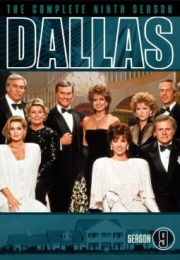 With the temperature dropping, it's time to find someone to keep you warm. Find your hookups with our online dating guide!
With the temperature dropping, it's time to find someone to keep you warm. Find your hookups with our online dating guide!
Ninth Season
- Drama
- 1985
- Buy the DVD
Reviewed by Ross Ruediger
()
here’s one major aspect of Season Nine of “Dallas” that must be mentioned before discussing it further: the entire season is a dream. Or, rather, the producers retconned it into a dream one of the main characters had.
It’s important to know this going in because I can’t in good conscience recommend it to viewers if they’re going to feel cheated after investing nearly 25 hours into this material. It had to be said at the start. Surprising, though, is that, despite what reputation suggests, it’s actually a really good season of “Dallas.” The “why” behind the dream I’ll get to later, and if you don’t want to be spoiled further on the issue, then I suggest turning back now. On the other hand, the box art for this set goes out of its way to exploit the season’s final scene. In any case, you can’t say you weren’t warned.
Good, now that that’s out of the way…
The story picks up where we left off last season, with the Ewing family dealing with the death of Bobby (Patrick Duffy). The first block of the season is obsessed with mourning him, which is understandable, as he was a major component of the show from the very beginning. Some people are affected worse than others, with a particular emphasis on J.R.’s (Larry Hagman) grieving. It’s a side of Mr. Nasty that we don’t often see, and it works very well here. On the flip side is Miss Ellie’s (Barbara Bel Geddes) reaction, which isn’t nearly as weepy as you’d expect. Geddes, who’d been off the show the entirety of Season Eight (she was replaced by Donna Reed), comes back with a vengeance. This is a tough-talking, take-no-shit-from-anyone Ellie. It’s great to have her back, and she’s such a presence that it’s almost as if she was never gone. At first, Pam (Victoria Principal) is devastated, but she recovers fairly quickly, due in no small part to her old lover Mark Graison (John Beck) sort of returning from the dead, in that the rare disease he’d been suffering from went into remission. For the first half of the season, Pam really comes into her own, as Bobby’s share of Ewing Oil becomes hers to control, and she and J.R. have to work it out. Meanwhile, Jenna (Priscilla Presley) starts heading downhill, feeling guilt and shame over her treatment of Bobby. If there’s one major misstep this season, it’s the handling of Jenna, with Presley given all manner of weird neuroses to play out. If there were an Emmy awarded for overacting, she would’ve won it. (Come to think of it, Jenna’s story was the weak link last season, too.) It’s a good thing the “Naked Gun” movies came along for Presley; playing it straight in the farce arena is much more her forte.
Back to ol’ J.R. (with “Dallas,” it always comes back to J.R.), lest I’ve led you to believe he’s gone soft, that’s not the case. He takes much of his pain out on Sue Ellen (Linda Gray), so much so that she ends up hitting the bottle (again), and for a few of the early episodes she hits “Rock Bottom” (the title of episode two). She becomes a drunk of the likes never before seen on “Dallas,” losing her purse, her wedding ring, and cavorting with the homeless on the streets of the city. In the hands of a lesser actress, it might seem comical, but Gray hits all the right notes, even if we feel we’ve already seen every take on this side of Sue Ellen. But it doesn’t last long, as Sue Ellen gets her crap together and for the majority of the season we see a Sue Ellen we’ve never seen before. She’s sober, never a victim, and completely in control of her life. She even takes a job at Graison Research at which she’s very successful. Given all the hell she’s been through in the eight seasons prior, it’s a delight to see Sue Ellen as she’s presented here. She’s a Season Nine highlight and it’s almost worth recommending for her alone. Almost.
“Dallas” needs villains that are more evil than J.R., and this season offered up Angelica Nero, played by Barbara Carrera, whom you might remember as Fatima Blush from the Bond flick “Never Say Never Again.” Angelica is practically a carbon copy of the Bond character, only stretched out over an entire TV season. She’s over the top in the best kind of way, and her duplicitous plots genuinely intrigue with each passing episode. And then there’s her wardrobe, which is a character unto itself. Costume designer Travilla went a little too far in Season Eight, what with his decking out every female in gaudy 80s attire. Here he pulls back with the rest of the cast, focusing on outlandishly decorating this woman with increasing fierceness (take that, Siriano!) as the season progresses. It’s as if she was Travilla’s pet project. There’s a scene where she sports a lizard-shaped broach on a weird hat that must be seen to be appreciated. Of course, since this is all a dream, this is the only place where you’ll ever see Angelica Nero, but the season can easily be recommended based solely on her shenanigans and “colorful” outfits. Her ongoing deadly ping-pong game with J.R. is a standout, because she seems to be someone just devious enough to outsmart him.
There’s plenty of other good stuff to recommend, but obviously one doesn’t want to reveal too much. Donna (Susan Howard) and Ray (Steve Kanaly) deal with family issues, as Donna’s pregnant at the season’s start. There are problems for them every step of the way, and their storyline gives the season heaping doses of heart. Jack Ewing (Dack Rambo) is a major character and excellent throughout, proving to be a much more thoughtful guy than his introductory episodes last season would have led you to believe. John Beck’s Mark Graison also delivers solid goods as he tries to figure out a way into Pam’s heart after the Bobby tragedy. Indeed, the two men together make up for the absence of Patrick Duffy, and it feels as if that was clearly the aim: to spread the various dramatic sides of Bobby across these two other characters. Surprisingly, it works. J.R. and Sue Ellen’s son, John Ross (Omri Katz), is given more screen time than before, while Katz continues to grow…both in size and as an actor. One of the great joys of watching “Dallas” over the long haul is seeing this kid mature, imagining what it must have been like to be raised on that set.
Some noteworthy appearances include Marc Singer (The Beast Master himself, who also played Mike Donovan on “V”), who has a lengthy storyline as a shady guy from Bobby’s high school days that shows up to cash in on an emerald scheme Bobby invested in. Hardcore “Deep Space Nine” fans might appreciate Barry Jenner (who played Admiral Ross on that series) as a doctor trying to steal Sue Ellen’s heart. Play a game of “Where’s Waldo?” by searching for the Professor (Russell Johnson) from “Gilligan’s Island,” who briefly appears in one episode as a sheriff. Then there’s J.R.’s secretary, Sly, played by Deborah Rennard. Sly’s been a fixture as far back as Season Five, but what many people probably don’t know is that Rennard has been married to writer/director/producer Paul Haggis since 1997. Thing is, I love Sly. She’s a character so slavishly, unquestionably devoted to J.R. Ewing that she fascinates – and it doesn’t hurt that she’s one of the sexiest fixtures on the show.
Other characters suffer weak writing this season, but never so much that it affects the overall drama. Jamie Ewing (Jenilee Harrison), who was so strong in Season Eight, is used as little more than an excuse to give Cliff Barnes (Ken Kerchevel) a moral conscience. Barnes himself isn’t even as central as usual, but he’s still a dick and provides the occasional deluded comic relief. As strong as Ellie is, husband Clayton Farlow (Howard Keel) has almost nothing to do, as if the writers fear crafting a character as strong as Jock. Deborah Shelton is as bad an actress as ever, and her Mandy Winger is given more screen time than necessary, yet she’s never really allowed to become an irritation. Charlene Tilton’s Lucy is gone for the whole shebang; supposedly on a very extended honeymoon, she can’t even make it home for Bobby’s funeral.
And on that note, this is as ideal a place as any to delve back into “the dream.”
The final minute of the season sees Pam waking up in bed alone after just having married Mark Graison. She hears the shower sprinkling and goes toward it. She opens the shower door and the naked man inside turns around and is none other than Patrick Duffy. He smiles and says, “Good morning!” Cue end credits.
At the time this was broadcast, nobody knew for sure this was Bobby. Nobody even knew Season Nine was a dream. Not until the opening moments of Season Ten were both confirmed. The closing credits read “Patrick Duffy as ____,” and that’s it. Duffy wanted out of “Dallas” after Season Eight, as he wanted to get into film and do other things. The ratings for “Dallas” sagged without him (although whether this was due to his absence is arguable), and Duffy’s potential “other” career didn’t take off; “Dallas” wanted him back, and he was happy to return to a safe haven. And yet, the show had killed Bobby off so thoroughly that, even by soap standards, it was impossible to logically bring the character back. According to “Dallas” legend, it was Duffy’s wife who first suggested, “The only way you could do it is if it had all been a dream.” And so Season Nine became Pam’s dream, and the most infamous “Dallas” moment after “Who Shot J.R.?” was born.
I love Patrick Duffy and I love Bobby Ewing, but I have to admit after viewing Season Nine: the show – weak ratings be damned – worked just fine without him. Three components are needed to make “Dallas” fly: J.R. Ewing, oil, and Texas. Everything else is disposable. There are some great storylines and character development that had to be shitcanned because of the dream (I’ll comment further once the next season is released), but nothing was as tragic a loss as the character of Mark Graison. John Beck, who was as good an actor as any on “Dallas” (you might remember him as Moonpie in “Rollerball,” or Erno Windt in “Sleeper”), must have wanted to piss all over the show after what was done to him. They erased Graison from existence after spending a whole season setting him up as a major player, going so far as to build the finale around his and Pam’s wedding, only to pull the rug out from under. I guess them’s the breaks, but it doesn’t make it right. Nevertheless, I wouldn’t get so worked up if I hadn’t been so invested in the season. It’s damn fine “Dallas,” and one wonders into what direction the show would’ve headed if these 31 episodes hadn’t been written off as having never happened. It’s called “the dream season,” and I said over and over watching it, “This is a very elaborate dream.” Rather than a dream, it’s better to think of it as an alternate “Dallas” universe, times and places where events occurred that would never be acknowledged again.
Special Features: As has become the norm for “Dallas” sets, there’s a mere one featurette here. It runs 15 minutes and is called “Seasons of Change.” It’s dedicated to discussing the dream aspect of the season as well the absence and return of Bel Geddes. It’s a decent enough piece, but one wishes it was about 15 minutes longer as it comes to a close.
You can follow us on Twitter and Facebook for content updates. Also, sign up for our email list for weekly updates and check us out on Google+ as well.











